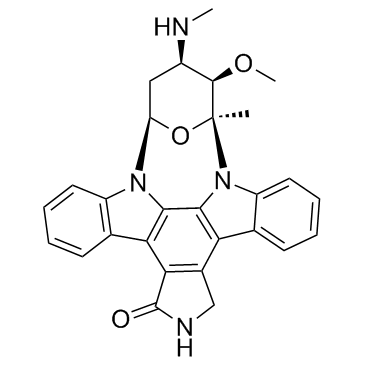Staurosporine

Staurosporine structure
|
Common Name | Staurosporine | ||
|---|---|---|---|---|
| CAS Number | 62996-74-1 | Molecular Weight | 466.531 | |
| Density | 1.6±0.1 g/cm3 | Boiling Point | 677.5±55.0 °C at 760 mmHg | |
| Molecular Formula | C28H26N4O3 | Melting Point | 270ºC | |
| MSDS | USA | Flash Point | 363.6±31.5 °C | |
| Symbol |

GHS08 |
Signal Word | Danger | |
|
TAp73 promotes cell survival upon genotoxic stress by inhibiting p53 activity.
Oncotarget 5(18) , 8107-22, (2014) p53 plays a key role in regulating DNA damage response by suppressing cell cycle progression or inducing apoptosis depending on extent of DNA damage. However, it is not clear why mild genotoxic stress favors growth arrest, whereas excessive lesions signal cel... |
|
|
Unmethylated CpG motifs in the L. donovani DNA regulate TLR9-dependent delay of programmed cell death in macrophages.
J. Leukoc. Biol. 97(2) , 363-78, (2015) Regulation of macrophage PCD plays an important role in pathogenesis of leishmaniasis. However, the precise involvement of any parasite molecule in this process remains uncertain. In the current study, in silico wide analysis demonstrated that genes in the Le... |
|
|
Higher vulnerability and stress sensitivity of neuronal precursor cells carrying an alpha-synuclein gene triplication.
PLoS ONE 9(11) , e112413, (2014) Parkinson disease (PD) is a multi-factorial neurodegenerative disorder with loss of dopaminergic neurons in the substantia nigra and characteristic intracellular inclusions, called Lewy bodies. Genetic predisposition, such as point mutations and copy number v... |
|
|
TRPM7 regulates proliferation and polarisation of macrophages.
J. Cell Sci. 127(21) , 4561-6, (2014) Ion channels play pivotal roles in regulating important functions of macrophages, such as cytokine and chemokine production, migration, proliferation, phagocytosis and others. In this study, we have identified the transient receptor potential cation channel, ... |
|
|
Caspase-dependent cell death-associated release of nucleosome and damage-associated molecular patterns.
Cell Death Dis. 5 , e1494, (2014) Apoptosis, which is anti-inflammatory, and necrosis, which is pro-inflammatory, represent the extremes of the cell death spectrum. Cell death is complex and both apoptosis and necrosis can be observed in the same cells or tissues. Here, we introduce a novel c... |
|
|
PRL-3 mediates the protein maturation of ULBP2 by regulating the tyrosine phosphorylation of HSP60.
J. Immunol. 194(6) , 2930-41, (2015) Many malignant cells release the NKG2D ligand ULBP2 from their cell surface to evade immunosurveillance by NK cells and CD8 T cells. Although the shedding mechanism remains unclear, various inhibitors of matrix metalloproteinases have been shown to efficientl... |
|
|
Apoptotic, inflammatory, and fibrogenic effects of two different types of multi-walled carbon nanotubes in mouse lung.
Arch. Toxicol. 88(9) , 1725-37, (2014) There is increasing concern about the toxicity of inhaled multi-walled carbon nanotubes (MWCNTs). Pulmonary macrophages represent the primary cell type involved in the clearance of inhaled particulate materials, and induction of apoptosis in these cells has b... |
|
|
Activated platelets rescue apoptotic cells via paracrine activation of EGFR and DNA-dependent protein kinase.
Cell Death Dis. 5 , e1410, (2014) Platelet activation is a frontline response to injury, not only essential for clot formation but also important for tissue repair. Indeed, the reparative influence of platelets has long been exploited therapeutically where application of platelet concentrates... |
|
|
The effects of harvesting media on biological characteristics and repair potential of neural stem cells after traumatic brain injury.
PLoS ONE 9(9) , e107865, (2014) Various solutions are utilized widely for the isolation, harvesting, sorting, testing and transplantation of neural stem cells (NSCs), whereas the effects of harvesting media on the biological characteristics and repair potential of NSCs remain unclear. To ex... |
|
|
A small molecule with anticancer and antimetastatic activities induces rapid mitochondrial-associated necrosis in breast cancer.
J. Pharmacol. Exp. Ther. 353(2) , 392-404, (2015) Therapy for treatment-resistant breast cancer provides limited options and the response rates are low. Therefore, the development of therapies with alternative chemotherapeutic strategies is necessary. AG311 (5-[(4-methylphenyl)thio]-9H-pyrimido[4,5-b]indole-... |